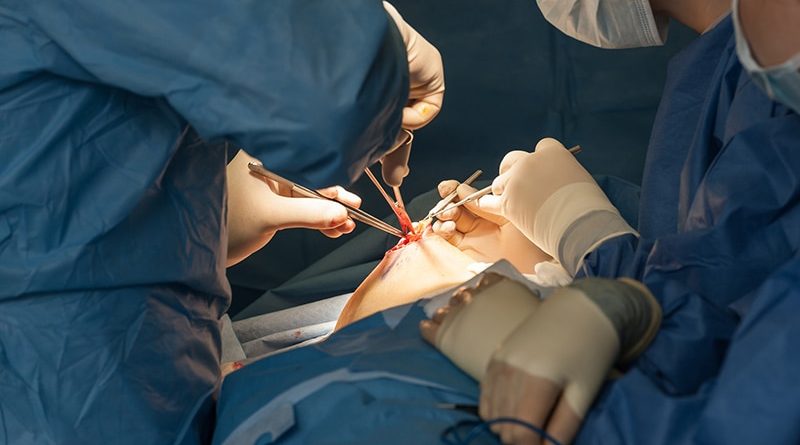Intraoperative Pathology Spurs Overtreatment in Mastectomy
Early stage breast cancer patients who undergo a mastectomy and have a pathological analysis of their sentinel lymph nodes (SLN) performed during surgery are more likely to be overtreated with both axillary lymph node dissection (ALND) and axillary radiation (AxRT), warned US investigators.
The team studied data on more than 40,000 clinically node negative women who underwent upfront mastectomy. Just over 8000 patients were found to have one to two SLN, with intraoperative pathology performed in approximately one third.
Intraoperative pathology was associated with a more than eightfold increase in the likelihood of performing both ALND and AxRT, far more than any other factor.
These results provide “evidence that a significant percentage of the mastectomy patients with limited disease in up to two SLNs may be overtreated…simply because their pathology results are read and acted on while they are on the operating table,” said senior author Olga Kantor, MD, MS, associate program director, Breast Surgical Oncology Fellowship Program, Brigham and Women’s Hospital and Dana-Farber Cancer Institute, Boston, Massachusetts.
“Notably, post-surgical decisions typically involve a multidisciplinary team, including radiation oncologists, which will likely result in a more integrated overall treatment plan,” she commented in a statement.
“This study suggests that surgeons should delay ALND decision-making until a later time to avoid overtreating patients,” Kantor emphasized.
The research is due to be presented on April 28 at the 24th American Society of Breast Surgeons (ASBrS) Annual Meeting, and was highlighted in a pre-meeting press briefing.
Approached for comment on the new findings, Sarah L. Blair, MD, professor and vice chair, Department of Surgery, University of California San Diego Health, noted that “there is a great deal of data on de-escalation in axillary surgery in patients undergoing breast conservation with radiation.”
Blair, who was not involved in the study, noted that, while there are some studies in mastectomy patients with equal oncologic results, “the topic remains more controversial.”
“This study highlights that surgeons strongly consider de-escalating axillary surgery in mastectomy patients to reduce long-term complications,” she told Medscape Medical News.
“If possible, these patients should be discussed in a multidisciplinary fashion ahead of time,” she emphasized.
“If surgeons send the lymph nodes for frozen section then, as this paper demonstrates, they will act on the information and perform axillary dissection for early stage disease.”
Study Details
At the press briefing for the study, Kantor explained that several clinical trials, including AMAROS, have already “established the safety of axillary observation or AxRT as an alternative to ALND” in clinically node negative breast cancer patients found to have one to two positive SLN.
She noted that “mastectomy patients were included in these trials, but they made up a minority” of the populations, ranging from 9% to 18%, “and so controversy remains over the optimal axillary management” in this patient population.
Kantor said that intraoperative pathology assessment “can help avoid the need to return to the operating room for additional axillary surgery” by checking the SLN at the time.
However, acting on the results during the procedure “does not allow for multidisciplinary discussion” and can mean that patients end up having both ALND and postoperative AxRT.
“This dual approach may result in axillary overtreatment in patients who may otherwise have been eligible for axillary radiation alone,” she underlined.
Moreover, a recent survey of 680 surgeons by the ASBrS found that 52% were performing routine intraoperative pathology assessment of SLN, and 78% of those said they would perform ALND if the results came back positive.
To investigate the impact of intraoperative pathology assessment on axillary management in mastectomy patients who would have been eligible for the AMAROS trial, the team examined data from the US National Cancer Database.
They included cT1-2N0 breast cancer patients who had upfront mastectomy in 2018-2019 and were found to have one to two positive SLN.
They defined intraoperative pathology assessment as:
-
“Not done/not acted on” if ALND was either not performed or performed at a later date than the pathology assessment.
-
“Done/acted on” if both ALND and the pathology assessment were carried out on the same day.
In addition, AxRT was defined as postmastectomy radiation to the chest wall that included radiation to the draining lymph nodes.
The researchers identified 40,467 patients, of whom 20.3% had one to two positive SLN. Among those, axillary management consisted of observation in 33.2%, ALND in 26.6%, AxRT in 22.2%, and ALND plus AxRT in 18.0%.
Overall, 37.2% of the patients underwent intraoperative pathology and 62.8% did not, 11.8% of whom later returned to the operating room for ALND.
Patients who underwent intraoperative pathology were more likely than those who did not to have cT2 disease (48.0% vs 44.1%), lympho-vascular invasion (43.4% vs 37.1%), two positive SLN (26.5% vs 19.2%), and macrometastasis (87.6% vs 64.2%, P < .001 for all).
Rates of ALND plus AxRT were significantly higher in patients who had intraoperative pathology done/acted on than in those whom intraoperative pathology was not done/not acted on, at 41.0% vs 4.9% (P < .001).
Adjusted multivariate analysis indicated that receipt of ALND plus AxRT was significantly associated with intraoperative pathology being done/acted on vs being not done/acted on, at an odds ratio of 8.99 (P < .001).
There were also significant associations between having both procedures and macrometastasis in the SLN, at an odds ratio vs micrometastasis of 3.38 (P < .001), and the number of total positive SLN, at odds ratio vs 1 of 2.14 for two nodes, 3.92 for three nodes, and 5.32 for > three nodes (P < .001 for all).
The researchers also found that lobular tumors on histologic analysis were associated with having ALND plus AxRT, at an odds ratio vs ductal histology of 1.40 (P < .001).
No funding was declared. Kantor and Blair report no relevant financial relationships.
24th ASBrS Annual Meeting: Abstract 1388031. To be presented April 28, 2023.
For more news, follow Medscape on Facebook, Twitter, Instagram, and YouTube.
Source: Read Full Article



